Long-Term CBCT Evaluation of Mandibular Third Molar Changes after Distalization in Adolescents
Abstract
1. Introduction
2. Materials and Methods
2.1. CBCT Reference Planes and Measurements
2.2. Statistical Analysis
3. Results
4. Discussion
5. Conclusions
- The first and second molars exhibited distal movements of 2.3 and 1.7 mm, respectively, with distal crown tipping after distalization. There were no significant changes in the angulations of the third molars.
- The treated group showed a downward and buccal position of the third molars after distalization in the long-term compared to the control group.
Author Contributions
Funding
Institutional Review Board Statement
Informed Consent Statement
Data Availability Statement
Acknowledgments
Conflicts of Interest
References
- Sugawara, J.; Daimaruya, T.; Umemori, M.; Nagasaka, H.; Takahashi, I.; Kawamura, H.; Mitani, H. Distal movement of mandibular molars in adult patients with the skeletal anchorage system. Am. J. Orthod. Dentofac. Orthop. 2004, 125, 130–138. [Google Scholar] [CrossRef] [PubMed]
- Kook, Y.-A.; Park, J.H.; Bayome, M.; Sa’Aed, N.L. Correction of severe bimaxillary protrusion with first premolar extractions and total arch distalization with palatal anchorage plates. Am. J. Orthod. Dentofac. Orthop. 2015, 148, 310–320. [Google Scholar] [CrossRef] [PubMed]
- Kook, Y.-A.; Bayome, M.; Trang, V.T.T.; Kim, H.-J.; Park, J.H.; Kim, K.B.; Behrents, R.G. Treatment effects of a modified palatal anchorage plate for distalization evaluated with cone-beam computed tomography. Am. J. Orthod. Dentofac. Orthop. 2014, 146, 47–54. [Google Scholar] [CrossRef] [PubMed]
- Oh, Y.-H.; Park, H.-S.; Kwon, T.-G. Treatment effects of microimplant-aided sliding mechanics on distal retraction of posterior teeth. Am. J. Orthod. Dentofac. Orthop. 2011, 139, 470–481. [Google Scholar] [CrossRef]
- Baccetti, T.; Franchi, L.; Stahl, F. Comparison of 2 comprehensive Class II treatment protocols including the bonded Herbst and headgear appliances: A double-blind study of consecutively treated patients at puberty. Am. J. Orthod. Dentofac. Orthop. 2009, 135, 698.e1–698.e10, discussion 698–699. [Google Scholar] [CrossRef]
- Chen, G.; Teng, F.; Xu, T.-M. Distalization of the maxillary and mandibular dentitions with miniscrew anchorage in a patient with moderate Class I bimaxillary dentoalveolar protrusion. Am. J. Orthod. Dentofac. Orthop. 2016, 149, 401–410. [Google Scholar] [CrossRef]
- Kook, Y.-A.; Park, J.H.; Kim, Y.; Ahn, C.S.; Bayome, M. Sagittal correction of adolescent patients with modified palatal anchorage plate appliances. Am. J. Orthod. Dentofac. Orthop. 2015, 148, 674–684. [Google Scholar] [CrossRef][Green Version]
- Yeon, B.M.; Lee, N.K.; Park, J.H.; Kim, J.M.; Kim, S.H.; Kook, Y.A. Comparison of treatment effects after total mandibular arch distalization with miniscrews vs. ramal plates in Class III patients. Am. J. Orthod. Dentofac. Orthop. 2022, 161, 529–536. [Google Scholar] [CrossRef]
- León-Salazar, V.; Janson, G.; de Freitas, M.R.; de Almeida, R.R.; León-Salazar, R. Nonextraction treatment of a skeletal Class III malocclusion. Am. J. Orthod. Dentofac. Orthop. 2009, 136, 736–745. [Google Scholar] [CrossRef]
- Lin, J.; Gu, Y. Preliminary investigation of nonsurgical treatment of severe skeletal Class III malocclusion in the permanent dentition. Angle Orthod. 2003, 73, 401–410. [Google Scholar]
- He, S.; Gao, J.; Wamalwa, P.; Wang, Y.; Zou, S.; Chen, S. Camouflage treatment of skeletal Class III malocclusion with multiloop edgewise archwire and modified Class III elastics by maxillary mini-implant anchorage. Angle Orthod. 2013, 83, 630–640. [Google Scholar] [CrossRef] [PubMed]
- Kinzinger, G.S.M.; Fritz, U.B.; Sander, F.G.; Diedrich, P.R. Efficiency of a pendulum appliance for molar distalization related to second and third molar eruption stage. Am. J. Orthod. Dentofac. Orthop. 2004, 125, 8–23. [Google Scholar] [CrossRef] [PubMed]
- Ricketts, R.M. A Principle of Arcial Growth of the Mandible. Angle Orthod. 1972, 42, 368–386. [Google Scholar] [PubMed]
- Kaplan, R.G. Some Factors Related to Mandibular Third Molar Impaction. Angle Orthod. 1975, 45, 153–158. [Google Scholar] [PubMed]
- Park, J.H.; Kim, Y.; Park, J.H.; Lee, N.K.; Kim, S.H.; Kook, Y.A. Long-term evaluation of maxillary molar position after distalization with and without second molar eruption. Am. J. Orthod. Dentofac. Orthop. 2021, 160, 853–861. [Google Scholar] [CrossRef]
- Kang, H.; Lee, N.K.; Kim, J.; Park, J.H.; Kim, Y.; Kook, Y.A. Factors associated with the maxillary third molar position after total arch distalization using a modified C-palatal plate in adolescents. Orthod. Craniofac. Res. 2021, 24 (Suppl. 1), 31–38. [Google Scholar] [CrossRef] [PubMed]
- Kook, Y.A.; Park, J.H.; Bayome, M.; Kim, S.; Han, E.; Kim, C.H. Distalization of the mandibular dentition with a ramal plate for skeletal Class III malocclusion correction. Am. J. Orthod. Dentofac. Orthop. 2016, 150, 364–377. [Google Scholar] [CrossRef]
- Tai, K.; Park, J.H.; Tatamiya, M.; Kojima, Y. Distal movement of the mandibular dentition with temporary skeletal anchorage devices to correct a Class III malocclusion. Am. J. Orthod. Dentofac. Orthop. 2013, 144, 715–725. [Google Scholar] [CrossRef]
- Nakamura, M.; Kawanabe, N.; Kataoka, T.; Murakami, T.; Yamashiro, T.; Kamioka, H. Comparative evaluation of treatment outcomes between temporary anchorage devices and Class III elastics in Class III malocclusions. Am. J. Orthod. Dentofac. Orthop. 2017, 151, 1116–1124. [Google Scholar] [CrossRef]
- Yu, J.; Park, J.H.; Bayome, M.; Kim, S.; Kook, Y.-A.; Kim, Y.; Kim, C.-H. Treatment effects of mandibular total arch distalization using a ramal plate. Korean J. Orthod. 2016, 46, 212–221. [Google Scholar] [CrossRef]
- Gu, Y.; McNamara, J.A., Jr. Mandibular growth changes and cervical vertebral maturation: A cephalometric implant study. Angle Orthod. 2007, 77, 947–953. [Google Scholar] [CrossRef] [PubMed]
- McNamara, J.A.; Franchi, L. The cervical vertebral maturation method: A user’s guide. Angle Orthod. 2018, 88, 133–143. [Google Scholar] [CrossRef] [PubMed]
- Bishara, S.E.; Andreasen, G. Third molars: A review. Am. J. Orthod. 1983, 83, 131–137. [Google Scholar] [CrossRef]
- Vaden, J.L.; Kiser, H.E. Straight talk about extraction and nonextraction: A differential diagnostic decision. Am. J. Orthod. Dentofac. Orthop. 1996, 109, 445–452. [Google Scholar] [CrossRef]
- Richardson, M.E. The etiology and prediction of mandibular third molar impaction. Angle Orthod. 1977, 47, 165–172. [Google Scholar] [PubMed]
- Kim, S.J.; Choi, T.H.; Baik, H.S.; Park, Y.C.; Lee, K.J. Mandibular posterior anatomic limit for molar distalization. Am. J. Orthod. Dentofac. Orthop. 2014, 146, 190–197. [Google Scholar] [CrossRef]
- Kang, J.M.; Park, J.H.; Bayome, M.; Oh, M.; Park, C.O.; Kook, Y.A.; Mo, S.S. A three-dimensional finite element analysis of molar distalization with a palatal plate, pendulum, and headgear according to molar eruption stage. Korean J. Orthod. 2016, 46, 290–300. [Google Scholar] [CrossRef]
- Richardson, M.E.; Richardson, A. Lower third molar development subsequent to second molar extraction. Am. J. Orthod. Dentofac. Orthop. 1993, 104, 566–574. [Google Scholar] [CrossRef]
- Behbehani, F.; Artun, J.; Thalib, L. Prediction of mandibular third-molar impaction in adolescent orthodontic patients. Am. J. Orthod. Dentofac. Orthop. 2006, 130, 47–55. [Google Scholar] [CrossRef]
- Oh, E.; Ahn, S.J.; Sonnesen, L. Evaluation of growth changes induced by functional appliances in children with Class II malocclusion: Superimposition of lateral cephalograms on stable structures. Korean J. Orthod. 2020, 50, 170–180. [Google Scholar] [CrossRef]
- Adams, G.L.; Gansky, S.A.; Miller, A.J.; Harrell, W.E., Jr.; Hatcher, D.C. Comparison between traditional 2-dimensional cephalometry and a 3-dimensional approach on human dry skulls. Am. J. Orthod. Dentofac. Orthop. 2004, 126, 397–409. [Google Scholar] [CrossRef] [PubMed]
- Nguyen, T.; Cevidanes, L.; Franchi, L.; Ruellas, A.; Jackson, T. Three-dimensional mandibular regional superimposition in growing patients. Am. J. Orthod. Dentofac. Orthop. 2018, 153, 747–754. [Google Scholar] [CrossRef] [PubMed]
- Chen, G.; Al Awadi, M.; Chambers, D.W.; Lagravère-Vich, M.O.; Xu, T.; Oh, H. The three-dimensional stable mandibular landmarks in patients between the ages of 12.5 and 17.1 years. BMC Oral. Health 2020, 20, 153. [Google Scholar] [CrossRef] [PubMed]
- Lee, Y.-J.; Kook, Y.-A.; Park, J.H.; Park, J.; Bayome, M.; Vaid, N.R.; Kim, Y. Short-term cone-beam computed tomography evaluation of maxillary third molar changes after total arch distalization in adolescents. Am. J. Orthod. Dentofac. Orthop. 2019, 155, 191–197. [Google Scholar] [CrossRef]
- Chen, L.L.; Xu, T.M.; Jiang, J.H.; Zhang, X.Z.; Lin, J.X. Longitudinal changes in mandibular arch posterior space in adolescents with normal occlusion. Am. J. Orthod. Dentofac. Orthop. 2010, 137, 187–193. [Google Scholar] [CrossRef]
- Tecco, S.; Grusovin, M.G.; Sciara, S.; Bova, F.; Pantaleo, G.; Capparé, P. The association between three attitude-related indexes of oral hygiene and secondary implant failures: A retrospective longitudinal study. Int. J. Dent. Hyg. 2018, 16, 372–379. [Google Scholar] [CrossRef]
- Sioustis, I.A.; Martu, M.A.; Aminov, L.; Pavel, M.; Cianga, P.; Kappenberg-Nitescu, D.C.; Luchian, I.; Solomon, S.M.; Martu, S. Salivary Metalloproteinase-8 and Metalloproteinase-9 Evaluation in Patients Undergoing Fixed Orthodontic Treatment before and after Periodontal Therapy. Int. J. Environ. Res. Public Health 2021, 18, 1583. [Google Scholar] [CrossRef]
- Polizzi, E.; Tetè, G.; Bova, F.; Pantaleo, G.; Gastaldi, G.; Capparè, P.; Gherlone, E. Antibacterial Properties and Side Effects of Chlorhexidine-Based Mouthwashes. A Prospective, Randomized Clinical Study. J. Osseointegr. 2019, 12, 2–7. [Google Scholar]
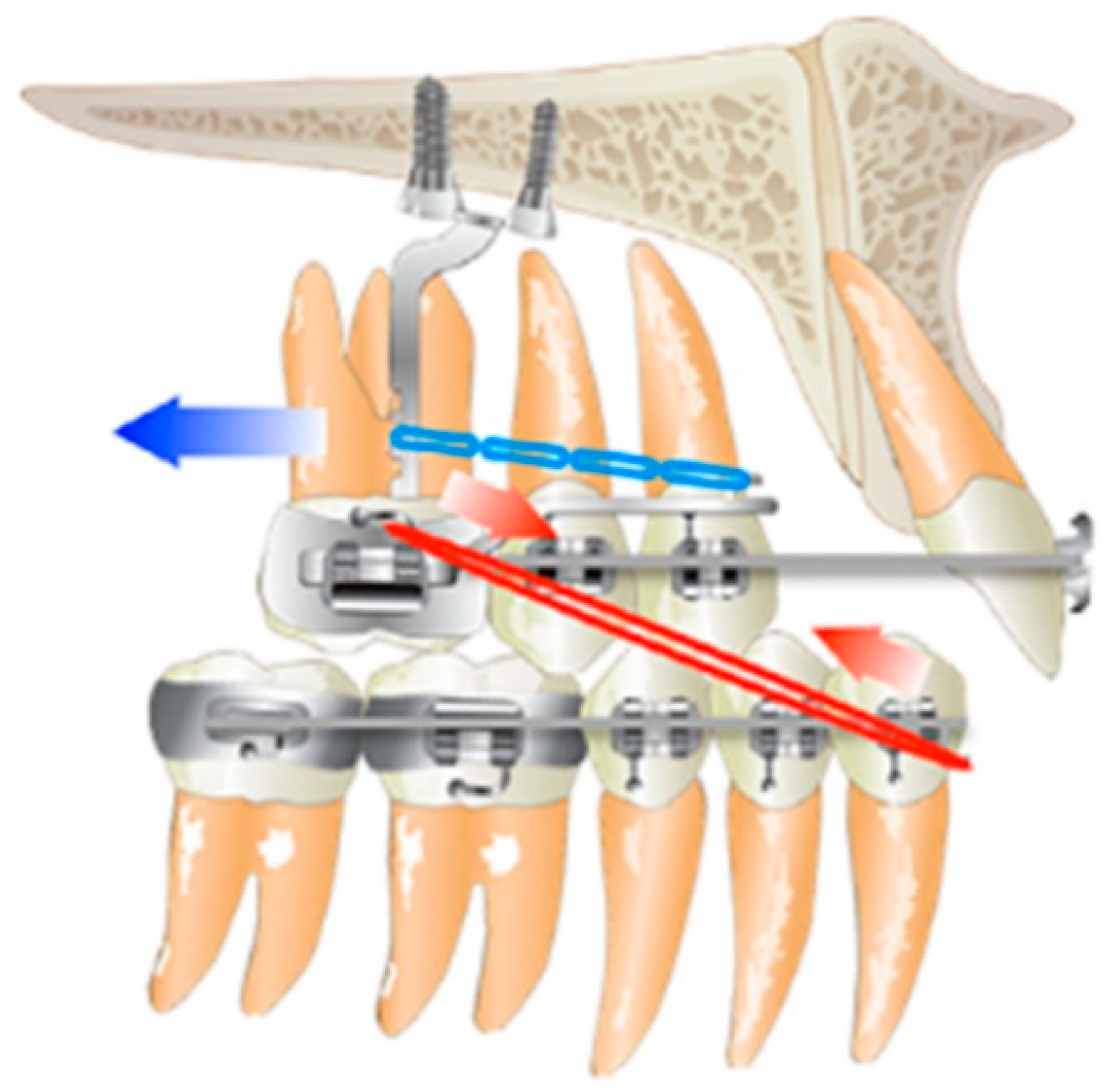
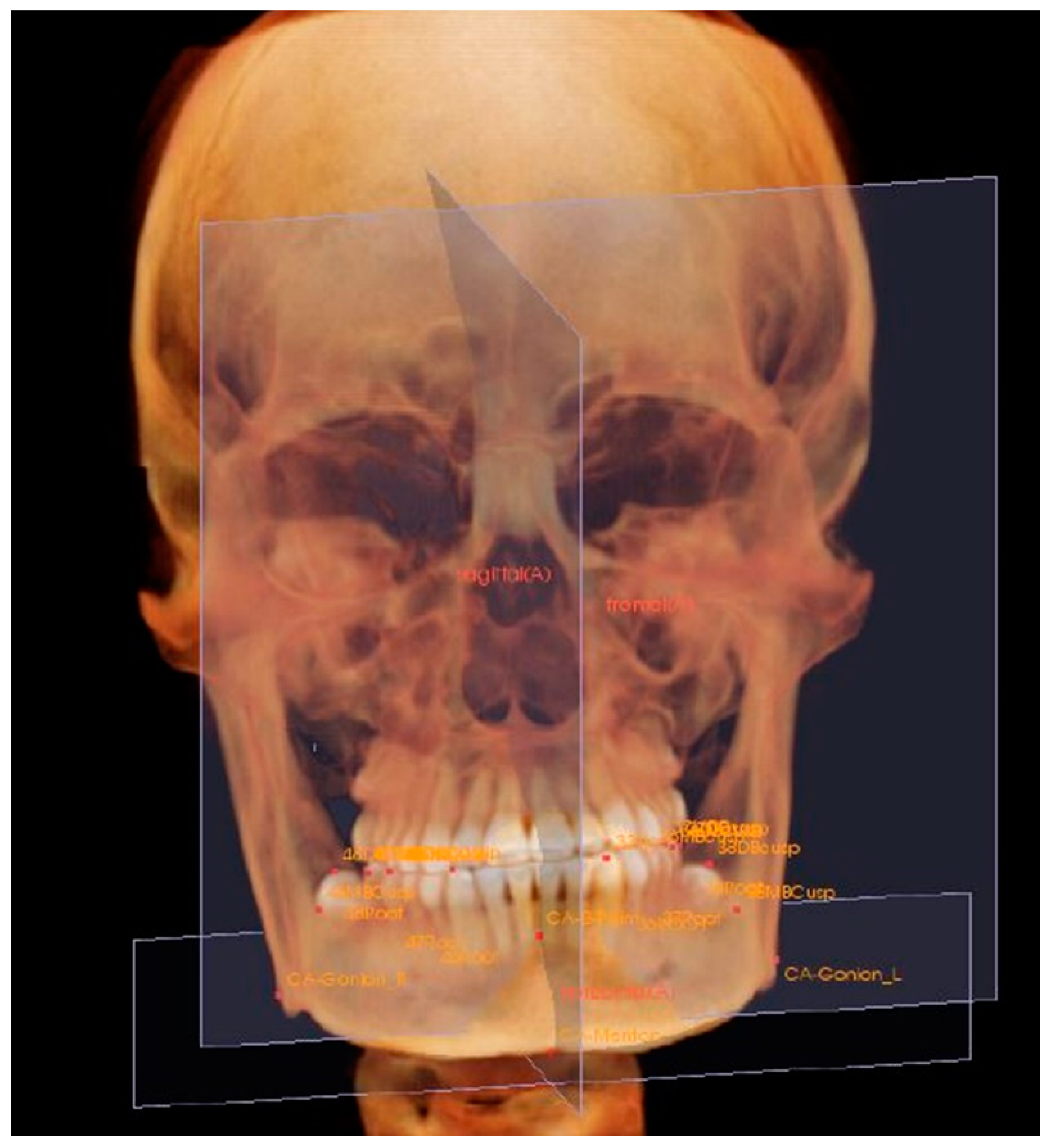
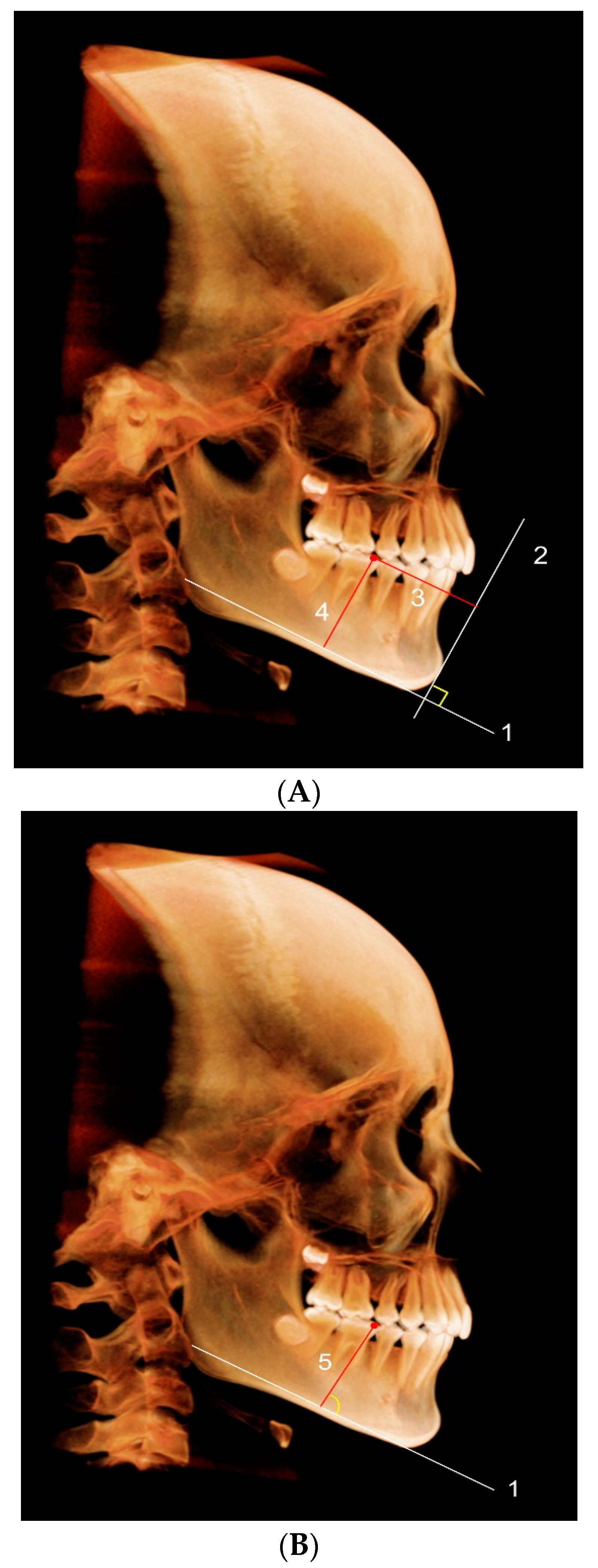
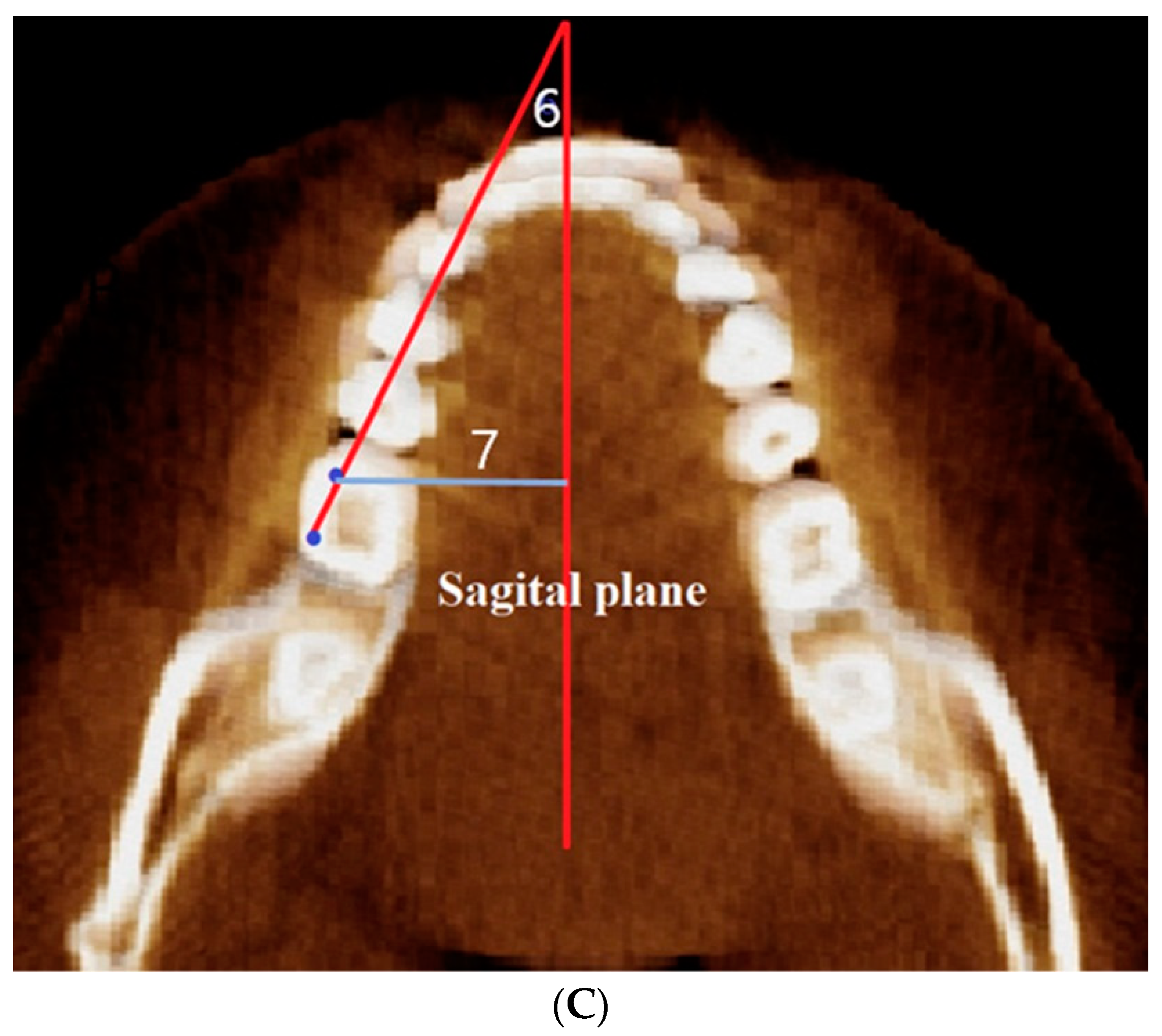
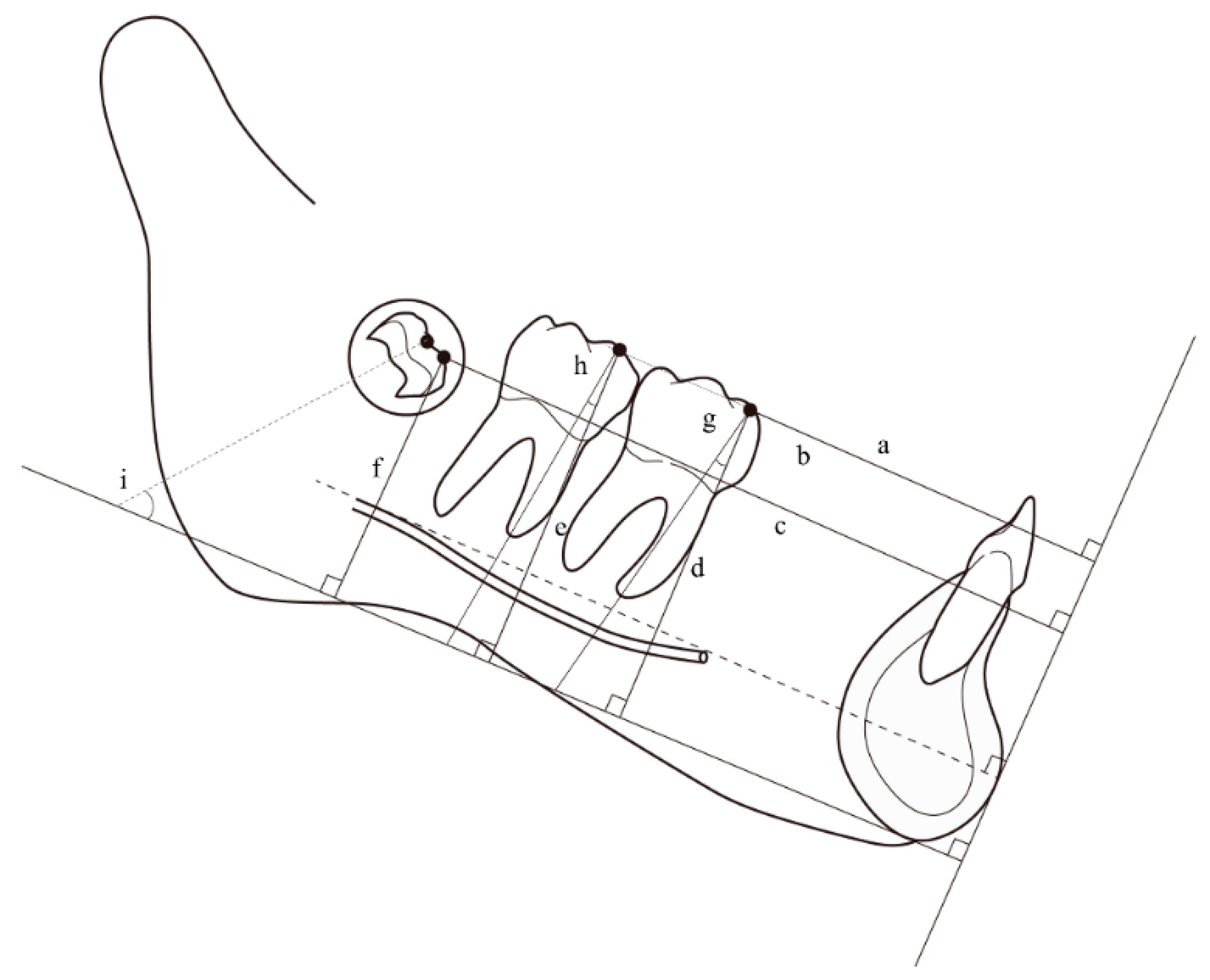
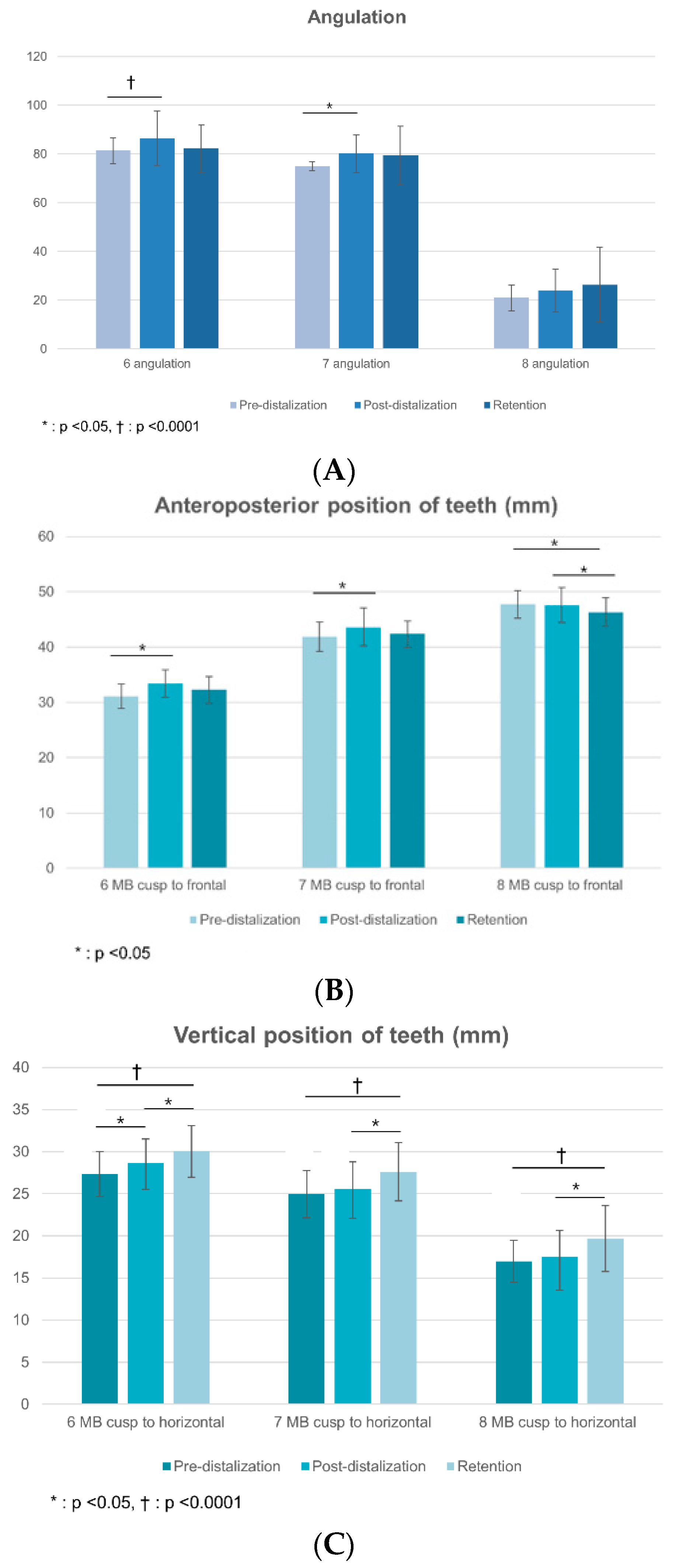
| Treated Group (n = 14) (26 Third Molars in 14 Patients) | Control Group (n = 21) (39 Third Molars in 21 Patients) | |||
|---|---|---|---|---|
| Predistalization (T1) | Postdistalization (T2) | Retention (T3) | ||
| Mean ± SD | Mean ± SD | Mean ± SD | Mean ± SD | |
| Age (y) | 12.8 ± 1.2 | 14.4 ± 1.3 | 20.1 ± 1.4 † | 21.3 ± 1.6 † |
| Gender | Male (n = 7) | Male (n = 11) | ||
| Female (n = 7) | Female (n = 10) | |||
| CVM | T1 | T2 | T3 | Control |
| CS2 (n = 5) | CS3 (n = 6) | CS5 (n = 3) | CS5 (n = 4) | |
| CS3 (n = 9) | CS4 (n = 8) | CS6 (n = 11) | (n = 17) | |
| Predistalization | Postdistalization | Retention | ||||
|---|---|---|---|---|---|---|
| Mean | SD | Mean | SD | Mean | SD | |
| Angulation (°) | ||||||
| 6 angulation | 81.45 | 5.36 | 86.60 | 1.88 | 82.15 | 5.44 |
| 7 angulation | 74.90 | 11.18 | 80.18 | 7.77 | 79.37 | 8.87 |
| 8 angulation | 20.95 | 9.72 | 23.93 | 11.93 | 26.33 | 15.31 |
| Rotation (°) | ||||||
| 6 rotation | 72.13 | 10.11 | 71.12 | 19.48 | 73.08 | 11.97 |
| 7 rotation | 49.54 | 22.40 | 54.72 | 22.23 | 53.71 | 21.94 |
| 8 rotation | 37.91 | 16.42 | 40.77 | 10.05 | 36.34 | 21.86 |
| Position (mm) | ||||||
| 6 MB cusp to frontal plane(mm) | 31.13 | 2.21 | 33.4 | 2.61 | 32.25 | 2.52 |
| 6 MB cusp to horizontal (mm) | 27.36 | 2.66 | 28.61 | 2.79 | 30.03 | 2.49 |
| 6 MB cusp to midsagittal (mm) | 26.33 | 3.13 | 25.60 | 2.83 | 26.36 | 3.86 |
| 7 MB cusp to frontal (mm) | 41.88 | 2.48 | 43.6 | 3.4 | 42.34 | 3.15 |
| 7 MB cusp to horizontal (mm) | 24.95 | 2.90 | 25.58 | 3.20 | 27.61 | 3.14 |
| 7 MB cusp to midsagittal (mm) | 29.26 | 4.43 | 28.62 | 2.71 | 29.28 | 5.11 |
| 8 MB cusp to frontal (mm) | 47.74 | 2.43 | 47.58 | 2.37 | 46.31 | 2.58 |
| 8 MB cusp to horizontal (mm) | 16.99 | 3.07 | 17.51 | 3.45 | 19.68 | 3.92 |
| 8 MB cusp to midsagittal (mm) | 40.66 | 2.31 | 40.69 | 2.10 | 39.02 | 4.08 |
| Width (mm) | ||||||
| Mandibular intercanine width | 28.25 | 2.76 | 28.35 | 2.47 | 28.01 | 1.90 |
| Mandibular intermolar width | 52.66 | 5.90 | 51.23 | 5.17 | 52.75 | 7.68 |
| Variables | T1–T2 | T2–T3 | T1–T3 | Post Hoc Analysis Bonferroni | |||||
|---|---|---|---|---|---|---|---|---|---|
| Mean | SD | Mean | SD | Mean | SD | P1 | P2 | P3 | |
| 6 angulation | −5.16 | 4.85 | 4.45 | 5.75 | −0.71 | 5.82 | <0.0001 | 0.001 | 1.000 |
| 7 angulation | −5.28 | 10.63 | 0.81 | 9.11 | −4.47 | 10.54 | 0.042 | 1.000 | 0.112 |
| 8 angulation | −2.97 | 6.78 | −2.40 | 16.17 | −5.38 | 15.23 | 0.084 | 1.000 | 0.218 |
| 6 rotation | 1.01 | 17.39 | −1.96 | 16.26 | −0.95 | 10.90 | 1.000 | 1.000 | 1.000 |
| 7 rotation | −5.18 | 23.56 | 1.01 | 24.39 | −4.17 | 26.91 | 0.763 | 1.000 | 1.000 |
| 8 rotation | −2.86 | 13.78 | 4.43 | 20.94 | 1.57 | 23.74 | 0.847 | 0.819 | 1.000 |
| 6 MB cusp to frontal (mm) | −2.26 | 2.43 | 1.14 | 3.51 | −1.12 | 3.03 | 0.012 | 0.737 | 0.571 |
| 6 MB cusp to horizontal (mm) | −1.25 | 1.83 | −1.42 | 2.03 | −2.67 | 2.04 | 0.004 | 0.003 | <0.0001 |
| 6 MB cusp to midsagittal (mm) | 0.72 | 2.69 | −0.76 | 3.35 | −0.03 | 3.66 | 0.498 | 0.724 | 1.000 |
| 7 MB cusp to frontal (mm) | −1.72 | 2.1 | 1.26 | 3.96 | −0.46 | 3.32 | 0.027 | 0.761 | 1 |
| 7 MB cusp to horizontal (mm) | −0.63 | 2.78 | −2.02 | 2.99 | −2.65 | 2.41 | 0.720 | 0.004 | <0.0001 |
| 7 MB cusp to midsagittal (mm) | 0.64 | 4.42 | −0.66 | 5.43 | −0.02 | 4.93 | 1.000 | 1.000 | 1.000 |
| 8 MB cusp to frontal (mm) | 0.16 | 1.1 | 1.27 | 1.64 | 1.43 | 1.88 | 1 | 0.038 | 0.042 |
| 8 MB cusp to horizontal (mm) | −0.52 | 1.66 | −2.16 | 2.89 | −2.69 | 3.15 | 0.321 | 0.001 | <0.0001 |
| 8 MB cusp to midsagittal (mm) | −0.03 | 1.95 | 1.67 | 3.89 | 1.64 | 4.18 | 1.000 | 0.095 | 0.143 |
| Mandibular intercanine width | −0.10 | 3.35 | 0.34 | 2.22 | 0.24 | 2.13 | 1.000 | 1.000 | 1.000 |
| Mandibular intermolar width | 1.43 | 4.79 | −1.52 | 6.32 | −0.09 | 6.78 | 0.851 | 1.000 | 1.000 |
| Variables | T3 | Control | p-Value | ||
|---|---|---|---|---|---|
| Average | SD | Average | SD | ||
| 6 angulation | 82.15 | 5.44 | 83.03 | 4.95 | 0.492 |
| 7 angulation | 79.37 | 8.87 | 78.36 | 7.56 | 0.614 |
| 8 angulation | 26.33 | 15.31 | 71.37 | 10.30 | <0.001 |
| 6 rotation | 73.08 | 11.97 | 72.90 | 12.13 | 0.952 |
| 7 rotation | 53.71 | 21.94 | 46.51 | 25.43 | 0.229 |
| 8 rotation | 36.34 | 21.86 | 31.37 | 17.38 | 0.301 |
| 6 MB cusp to frontal (mm) | 32.25 | 2.51 | 32.95 | 2.8 | 0.456 |
| 6 MB cusp to horizontal (mm) | 30.03 | 2.49 | 29.65 | 3.68 | 0.639 |
| 6 MB cusp to midsagittal (mm) | 26.36 | 3.86 | 25.15 | 2.06 | 0.098 |
| 7 MB cusp to frontal (mm) | 42.34 | 3.15 | 42.68 | 2.99 | 0.748 |
| 7 MB cusp to horizontal (mm) | 27.61 | 3.14 | 27.35 | 2.95 | 0.729 |
| 7 MB cusp to midsagittal (mm) | 29.28 | 5.11 | 27.72 | 3.41 | 0.135 |
| 8 MB cusp to frontal (mm) | 46.31 | 2.58 | 49.88 | 3.28 | 0.002 |
| 8 MB cusp to horizontal (mm) | 19.68 | 3.92 | 22.74 | 3.84 | 0.002 |
| 8 MB cusp to midsagittal (mm) | 39.02 | 4.08 | 35.07 | 4.62 | 0.001 |
| Mandibular intercanine width | 28.01 | 1.90 | 26.93 | 1.27 | 0.043 |
| Mandibular intermolar width | 52.75 | 7.68 | 50.62 | 2.72 | 0.203 |
Publisher’s Note: MDPI stays neutral with regard to jurisdictional claims in published maps and institutional affiliations. |
© 2022 by the authors. Licensee MDPI, Basel, Switzerland. This article is an open access article distributed under the terms and conditions of the Creative Commons Attribution (CC BY) license (https://creativecommons.org/licenses/by/4.0/).
Share and Cite
Hong, H.-R.; Lee, N.-K.; Park, J.H.; Ku, J.H.; Kim, J.; Bayome, M.; Mo, S.-S.; Kook, Y.-A. Long-Term CBCT Evaluation of Mandibular Third Molar Changes after Distalization in Adolescents. Appl. Sci. 2022, 12, 4613. https://doi.org/10.3390/app12094613
Hong H-R, Lee N-K, Park JH, Ku JH, Kim J, Bayome M, Mo S-S, Kook Y-A. Long-Term CBCT Evaluation of Mandibular Third Molar Changes after Distalization in Adolescents. Applied Sciences. 2022; 12(9):4613. https://doi.org/10.3390/app12094613
Chicago/Turabian StyleHong, Hye-Rim, Nam-Ki Lee, Jae Hyun Park, Ja Hyeong Ku, Jaehyun Kim, Mohamed Bayome, Sung-Seo Mo, and Yoon-Ah Kook. 2022. "Long-Term CBCT Evaluation of Mandibular Third Molar Changes after Distalization in Adolescents" Applied Sciences 12, no. 9: 4613. https://doi.org/10.3390/app12094613
APA StyleHong, H.-R., Lee, N.-K., Park, J. H., Ku, J. H., Kim, J., Bayome, M., Mo, S.-S., & Kook, Y.-A. (2022). Long-Term CBCT Evaluation of Mandibular Third Molar Changes after Distalization in Adolescents. Applied Sciences, 12(9), 4613. https://doi.org/10.3390/app12094613






